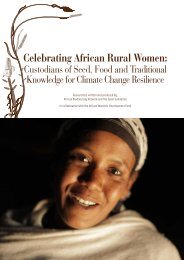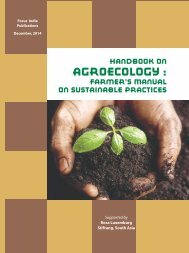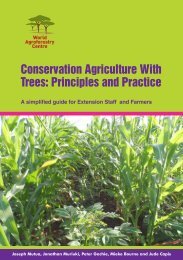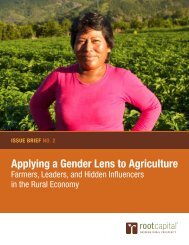1t0SC7l
1t0SC7l
1t0SC7l
Create successful ePaper yourself
Turn your PDF publications into a flip-book with our unique Google optimized e-Paper software.
1. The formal source of credit is granted by government institutions such as FIMAC and<br />
‘Crédit Agricole’. Few smallholders qualify for this and the interest rate is high.<br />
2. The informal source is that called ‘tontine’, explained above. Informal source of credit<br />
works better and farmers tend to prefer it to the formal.<br />
Farm investment<br />
Though most of farmers’ financial revenues come from agriculture, very little of it is directly reinvested<br />
in agricultural production. Table 2.4 gives the priority expenditures of farmers. One<br />
can observe that expenditures for agricultural activities come in fourth position, occasionally to<br />
buy fungicides for cocoa spray.<br />
Table 2.4. Farmer’s priority expenditures<br />
Priority Expenditures Rank Freq.(%) Priority Expenditures Rank Freq.(%)<br />
Kerosene, soap, drugs 1 68 Drink 7 47<br />
Children school fees 2 57 Food 8 29<br />
House building and repair 3 38 Seeds 9 32<br />
Agricultural material 4 45 Kitchen utensils 10 30<br />
Paid agricultural labour 5 33 Mourning / funeral 11 70<br />
Clothing 6 37 Gifts and assistance 12 78<br />
Sample size n = 200<br />
2.3.3 Cropping systems<br />
Cropping calendar<br />
Table 2.5 presents three cropping seasons. The first (‘Essep’), running from March to July, is<br />
the most important. Most bush fallow and forest land opened in December / January is used<br />
during that period for ‘ngon’ (Cucumeropsis mannii) cultivation. The long dry season running<br />
from mid-November to end of February allows the felling and drying of trees and branches from<br />
bush and forest fallow clearing. The total area cultivated by a farmer is large (see field size).<br />
Table 2.5. Cropping calendar in the study area.<br />
Growing Clearing of Felling of Burning Planting Harvest<br />
seasons understorey trees<br />
‘Essep’ December / January / January / March / April July<br />
1 st season January February February<br />
‘Oyon’ June / July July / August July / August August / November<br />
2 nd season<br />
September<br />
‘Assan’<br />
Valley bottom<br />
November December December /<br />
January<br />
December /<br />
January<br />
March<br />
The second growing season (‘Oyon’), from August to November, is less important than the first<br />
season; mostly Chromolaena fallow is cleared; the preceding short dry season running from<br />
July to mid-August is not long enough to allow tree felling and drying. The total area cultivated<br />
by a farmer is reduced (see fields size). Arable swamps and valley bottom are cultivated<br />
between December and March (‘Assan’) for the off-season production of food crops; but not all<br />
families own an ‘Assan’ crop field, since not everybody possesses an arable valley bottom or<br />
swamp.<br />
Land use types in a farm<br />
Farm agricultural land use can be divided in three types: home gardens (or ‘guie pion’) near the<br />
home, perennial plantations (cocoa, oil palm) at a somewhat greater distance, and shifting<br />
cultivation field (food crop fields and fallow) away from the farmer’s dwelling. The cultivation<br />
of food crop field shifts every season from one place to another by clearing and burning a tract<br />
of fallow land or primary forest. The fallow land can be a forest fallow (FF, ‘Afan’), a bush<br />
fallow (BF, ‘Nnom ekodok’) or a Chromolaena fallow (CF, ‘Ekodok ngoumgoum’). Arable<br />
13








